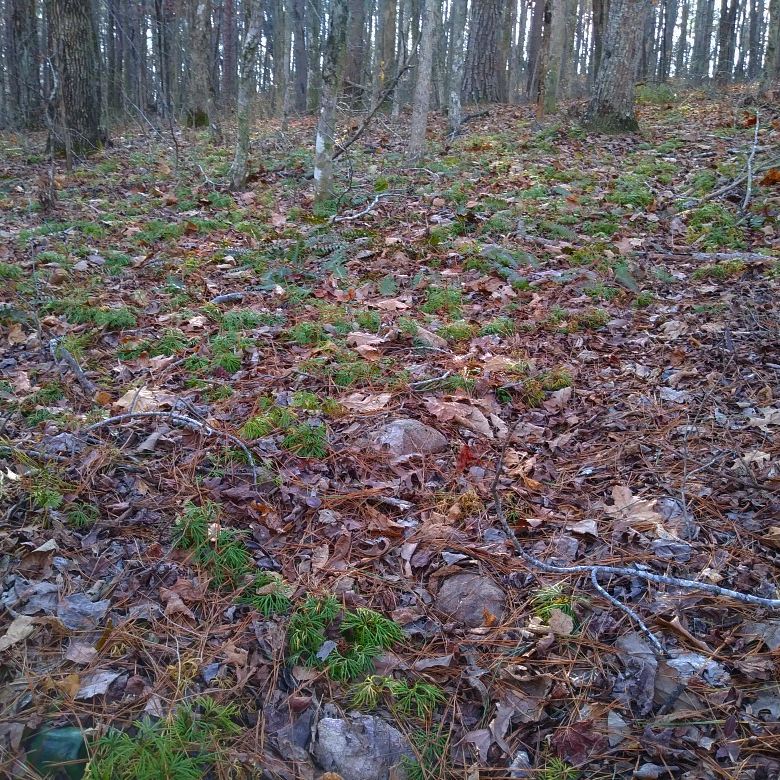Today’s plant for #WildEdibleWednesday is Diphasiastrum digitatum, or Lycopodium digitatum, depending on which taxonomist you ask. (If you actually care enough to ask, that is.) Commonly known as Creeping Cedar, Wolf’s Paw, Crowsfoot, or Fan Clubmoss, it’s one of the coolest-looking groundcovers in the Eastern Woodlands. It looks like something out of the age of the dinosaurs, because it is. Before that, actually. The first fossil records we have of this species are from the Carboniferous period, about 400 million years ago. Remains of this exact plant are being burned as coal this very day.
Despite being called Creeping Cedar, it’s not a cedar at all. It’s a clubmoss. Clubmosses are among the oldest families of vascular plants, and are closely related to ferns. Its Latin strong name, Lycopodium, means “wolf’s foot.” Creeping cedar is a herbaceous trailing groundcover that grows about 6” high and dozens of feet long. It grows slowly, but over the course of decades, a few plants can cover huge swaths of the forest floor. It is evergreen and textured much like, well… cedar. North Georgia is the southern tip of its range. It reasonably common all the way up the Appalachian range to Newfoundland and Quebec. It likes relatively shaded, moist (but not wet) areas underneath Virginia or Shortleaf pines.
Creeping cedar is not edible, but it has two ways that it’s useful for our purposes: its foliage is a great plant medicine, and its powdery spores have several unique practical uses. The dried leaves make a powerful tea. Collect them during summer and dry them carefully, and they’ll keep all year. Fresh leaves work also. This tea works well to counteract stomach ailments such as nausea, vomiting, and diarrhea. Taken over time, it can even help calm stomach ulcers and diverticulitis. In addition to helping digestive tract problems, it is also great for urinary tract health. It can help treat kidney and bladder infections. In traditional Native American medicine, it was also used to induce labor in pregnant women, but this use is far less common in herbal medicine today.
But perhaps the most interesting aspect of creeping cedar and other clubmosses are the spores. Known as Lycopodium powder, these spores, harvested in large quantities, have had a long history of practical and industrial uses. They are extremely hydrophobic, meaning they repel water very well – even to the point of being able to coat your hand with them, stick it in water, and it stay dry. Lycopodium powder has been used by pharmacists to coat pills, and in industrial applications to coat molds to keep things from sticking to them. For our purposes, it’s great as a foot and body powder to combat chafing and skin infections (another traditional use – the powder has natural anti-fungal properties), and as a coating for small items of gear to keep them dry. One of the best applications is to mix it into your flash tinder to combat moisture, which leads us to what might be the its coolest use… Lycopodium powder is highly flammable. This use was first discovered by Native Americans, who used it as a tinder booster for everyday use, as well as in ceremonies. Shamans would blow or toss a handful of the powder into fires for a bright, dramatic flash of light. Through much of the 20th century, lycopodium powder was used as the flash for photography, stage productions, and especially in fireworks. Check out this short video for an example of Lycopodium’s hydrophobic properties, as well as its flammability:
Now, as you can see, the bulk powder won’t light on its own, since it’s too dense to allow oxygen inside. But if you spread it out, say sprinkled as a thin layer on a loose flash tinder like cattail fluff or processed jute twine, it can amplify the reaction, in addition to repelling moisture. So lycopodium is not a flash tinder in its own right, but it is a very valuable fire extender and tinder preservative against moisture. The spores can be harvested wild from stalks that shoot up from the plants in mid-summer, but that process is time-consuming and labor-intensive when laboratory supply stores will sell you a squeeze bottle of lycopodium powder for about twelve bucks.
So whether its burning its remnants for coal, or its spores for flash effect, whether brewing it for medicinal tea or simply enjoying it, whether you call it creeping cedar, groundcedar, crowsfoot, or wolf’s paw, lycopodium or diphasiastrum, this clubmoss is undoubtedly one of the coolest and most unique plants in the Eastern Woodlands. Do you have any other tips or knowledge to share about creeping cedar? Tell us in the comments!
- Alex



